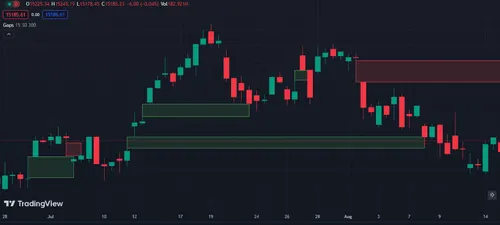Our partner, XM, lets you access a free demo account to apply your knowledge.
No hidden costs, no tricks.

Gaps happen when the opening price is significantly higher or lower than the price of a previous close. A typical gap happens when something major happens in the financial markets and prices are moving faster. Gaps can also occur during the opening of a trading session after weekends. In this guide, we will delve into the concept of gaps, clarifying what they are and demonstrating how you can develop trading strategies to capitalize on them.

Gaps are gaps between open and closing prices. Gaps happen when there is significant pressure on either side of the market. When a new candle opens, there is not enough time for the price to keep up with changes, and it opens noticeably below or above the previous candle’s close. In the case of stocks, commodities, indices, and other securities, gaps usually happen during the opening of the new trading day.
An upward gap happens when the price opens significantly higher than the previous close. It signals a strong bullish pressure in the market and can indicate a possible strong upward impulse.
A gap down is essentially the opposite of an upward gap, signaling a strong downward pressure in the market. When the price opens significantly below the previous close, we have a gap down or a bearish gap.
Gaps usually tend to close, meaning the price retreats to the previous close, which creates a gap in the first place. Traders use this phenomenon to capitalize on the short price movement.
However, depending on the experience level of a trader, it may be a risky business. Let’s consider a simple trading strategy to use the gap for profit-making.
This strategy is based on the principle that almost 75% of gaps typically close, meaning the price retreats to the previous close level and then continues with the trend. Here are the rules:
Step 1: Identify gap: Track price charts and identify a significant gap (up or down) in the FX market between the closing price in the previous session and the opening price of the current session.
Step 2: Direction: This step is straightforward: you just are planning to go short if there is a gap up and long if the gap is bearish.
Step 3: Stop Loss and Take Profit: This is the most important part as traders need to tightly control risks all the time. Determine your stop loss and take profit levels based on your risk tolerance and the size of the gap.
Step 4: Timeframe: Every strategy has a defined timeframe it is profitable. This strategy is usually applied to relatively short-term timeframes such as 1 hour and 4 hours.
Step 5: If the take profit is not hit within several hours, it is better to close the trade as there might be a continuation in the gap direction.
This strategy is not a recommendation to trade as it is risky business and requires serious testing and analysis. This is just for educational purposes.
Gaps occur when the opening price significantly differs from the previous close, often caused by major market events or the opening of a new trading session or trading day.
Gaps represent disparities between open and closing prices and often indicate strong market pressure. For various securities, gaps typically happen at the beginning of the trading day.
Gaps can be both bullish and bearish. Gup up is when the opening price is noticeably higher than the previous close. The opposite is true for gap down or bearish gap.
Gaps tend to close, meaning the price often reaches the previous close level. Traders often try to capitalize on this phenomenon.
The simple gap trading strategy involves identifying gaps, determining trade direction (short for gap up, long for gap down), setting stop-loss and take-profit levels, selecting a suitable timeframe, and closing the trade if the take-profit level isn't reached within several hours.
Trading gaps carry a significant risk of losing money without proper testing and experience and can lead to excessive losses. This is why strong risk control and backtesting are advised.
Our partner, XM, lets you access a free demo account to apply your knowledge.
No hidden costs, no tricks.